A standing desk can boost your health and productivity by reducing back pain, improving posture, and increasing circulation. You’ll find adjustable and fixed models, with motorized or manual options, to suit your needs. Proper setup involves positioning your monitor at eye level and keeping accessories within reach to prevent strain. To get the most benefits, incorporate movement and breaks throughout your day. Keep exploring to discover how to create a comfortable, ergonomic workspace tailored for you.
Key Takeaways
- Understand the benefits of standing desks, including reducing back pain and improving circulation, with proper ergonomic setup.
- Choose the right type (adjustable, fixed, desktop, standalone) and features (motorized or manual) based on your needs.
- Gradually transition by balancing sitting and standing, using ergonomic accessories like monitor risers and anti-fatigue mats.
- Maintain proper ergonomics: monitor at eye level, keyboard within reach, and good posture to prevent strain.
- Incorporate movement and regular breaks to enhance comfort and promote overall well-being during desk use.
Benefits of Using a Standing Desk

Using a standing desk can substantially boost your overall health and productivity. When you switch from sitting all day, you reduce risks like back pain, poor posture, and cardiovascular issues. Standing encourages better circulation and engages your muscles, helping you stay alert and focused. To maximize these benefits, consider ergonomic accessories such as anti-fatigue mats, monitor stands, and adjustable keyboard trays, which promote proper alignment and comfort. Be aware of standing desk myths, like the idea that standing all day is better or that it automatically solves health problems—balance is key. Incorporating a standing desk into your routine can lead to increased energy and reduced discomfort, making your workday more efficient and healthier. Just remember, moderation and proper setup are essential. Additionally, understanding the importance of contrast ratio can help you choose a monitor that reduces eye strain and enhances visual clarity during long hours of work.
A well-structured workspace organization also plays a significant role in maintaining ergonomic benefits and reducing clutter that can distract or cause discomfort during work.
Types of Standing Desks Available

There are several types of standing desks to choose from, each with its own advantages. You can pick between adjustable and fixed models, desktop units or standalone ones, and motorized or manual options. Understanding these differences helps you find the best fit for your workspace and needs. Incorporating ergonomic design principles into your choice can further enhance comfort and productivity. For example, adjustable models allow for customization to promote proper posture support, which is essential for long-term health. Additionally, considering the variety of styles available can help match your workspace decor and personal preferences. Being aware of screen height adjustments is also important for maintaining healthy neck and eye positioning during work sessions.
Adjustable vs. Fixed Models
When choosing between adjustable and fixed standing desks, it’s important to understand their differences to find the best fit for your needs. Adjustable desks let you switch between sitting and standing, promoting better ergonomics and flexibility. Adjustable desks also often feature Glycolic Acid benefits, which can be important for maintaining a healthy workspace environment by reducing skin irritation from prolonged wear of accessories. Fixed models, on the other hand, stay at one height, offering simplicity and stability. If you value customization, an adjustable desk allows you to incorporate ergonomic accessories and improve desk organization effortlessly. Fixed desks might suit those who prefer minimal setup or don’t need frequent height changes. Consider your workspace needs and comfort preferences carefully. Here’s a quick comparison:
| Feature | Adjustable Desk | Fixed Desk |
|---|---|---|
| Flexibility | High | Low |
| Ease of Use | Easy to change heights | No adjustment needed |
| Cost | Usually more expensive | More affordable |
Additionally, understanding your ergonomic needs can help in selecting the right model for long-term comfort.
Desktop vs. Standalone Units
Standing desks come in two main types: desktop units and standalone models. Desktop units sit on your existing desk, offering quick height adjustability, but they rely on your current desk’s surface and material. They’re portable and easy to move but may be limited in stability depending on their design and the desk material. Additionally, some desktop units incorporate adjustable mechanisms that enhance flexibility for different users. Standalone units are separate pieces of furniture designed specifically for standing work, providing more robust height adjustability and stability. They often feature durable desk materials like wood, metal, or composite, which can support various accessories and equipment. If you prefer a flexible setup, desktop units are convenient, but for a dedicated workspace with greater stability and customization, standalone units are the better choice. When selecting a durable furniture option, consider your workspace and preferences to ensure comfort and longevity. Incorporating professional-grade materials can also improve the overall durability and stability of your standing desk setup. For added longevity, consider ergonomic features that promote better posture and reduce strain during long work sessions.
Motorized vs. Manual Options
Motorized standing desks are equipped with electric motors that allow you to adjust the height at the push of a button, making shifts smooth and effortless. They’re ideal if you want quick, precise changes and don’t want to manually crank or lift. Manual options, like crank or pneumatic desks, require you to adjust height with physical effort, but they tend to be more affordable and quieter. When choosing between the two, consider your preferred level of convenience and budget. Adding desk accessories, such as monitor arms or organizer trays, can enhance your setup regardless of the desk type. Standing desk mats also improve comfort and reduce fatigue, especially if you switch between sitting and standing frequently. Knowing the symptoms of breast cancer can help you recognize potential health issues early, emphasizing the importance of regular health awareness. Additionally, understanding ergonomic features can help you select a desk that best supports your posture and health. Incorporating adjustability options into your workspace can further personalize your ergonomic setup and promote better comfort throughout the day. Whether motorized or manual, these features help you create a more ergonomic and personalized workspace.
How to Choose the Right Standing Desk for You
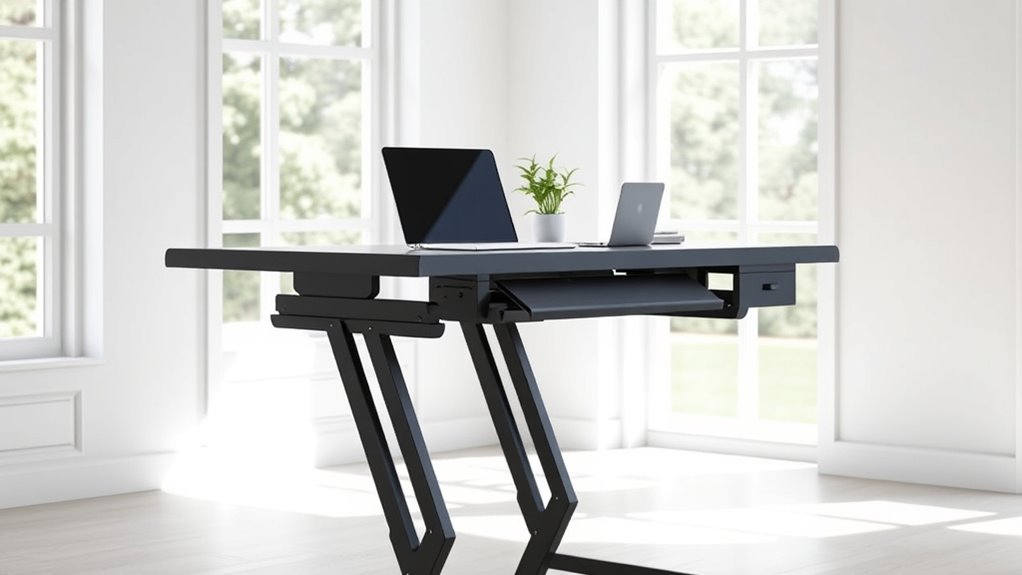
Choosing the right standing desk involves considering your specific needs, workspace, and preferences. First, think about your daily tasks—do you need extra space for desk accessories or multiple monitors? This helps determine the size and shape of the desk. Next, evaluate your workspace dimensions to confirm the desk fits comfortably without clutter. Comfort is key, so look for a desk compatible with standing desk mats that provide cushioning and support. Also, consider adjustability—an ergonomic height range will keep you comfortable during long work sessions. Don’t forget to factor in your budget and quality, choosing a sturdy desk that meets your needs without overspending. Additionally, exploring aesthetic hooks and wall organization solutions can help maximize your workspace efficiency and style. Investing in self-sufficiency tools like proper storage options can further enhance your setup. Remember to check stand desk hours to ensure your workspace remains functional during your working hours. Being aware of ergonomic principles can help you set up your desk to prevent discomfort and improve productivity. By evaluating these aspects, you’ll find a standing desk that boosts productivity and comfort.
Proper Setup and Ergonomics
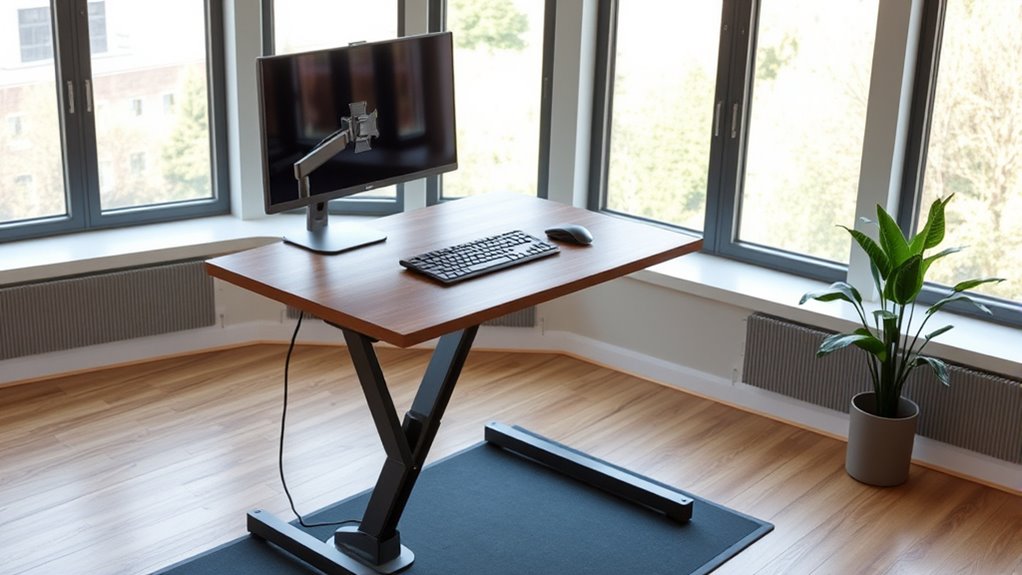
To guarantee you get the most benefit from your standing desk, setting it up correctly and maintaining good ergonomics are essential. First, adjust your monitor so the top of the screen is at eye level, preventing neck strain. Second, keep your keyboard and mouse close enough to avoid reaching, and use desk accessories like ergonomic wrist supports if needed. Third, learn keyboard shortcuts to reduce unnecessary movements, keeping your workflow efficient. Remember, a well-organized workspace promotes comfort and productivity. Regularly check your posture, ensuring your hips are aligned with your knees and your feet are flat on the floor. Proper setup minimizes fatigue and maximizes health benefits, making your standing desk a sustainable and effective workspace. Additionally, incorporating ergonomic principles into your setup can further enhance comfort and reduce strain during long periods of standing. Incorporating adjustable features can also help you customize your workspace to better support different body types and work habits, especially by adapting to various air quality levels that can affect comfort.
Tips for Transitioning to a Standing Desk
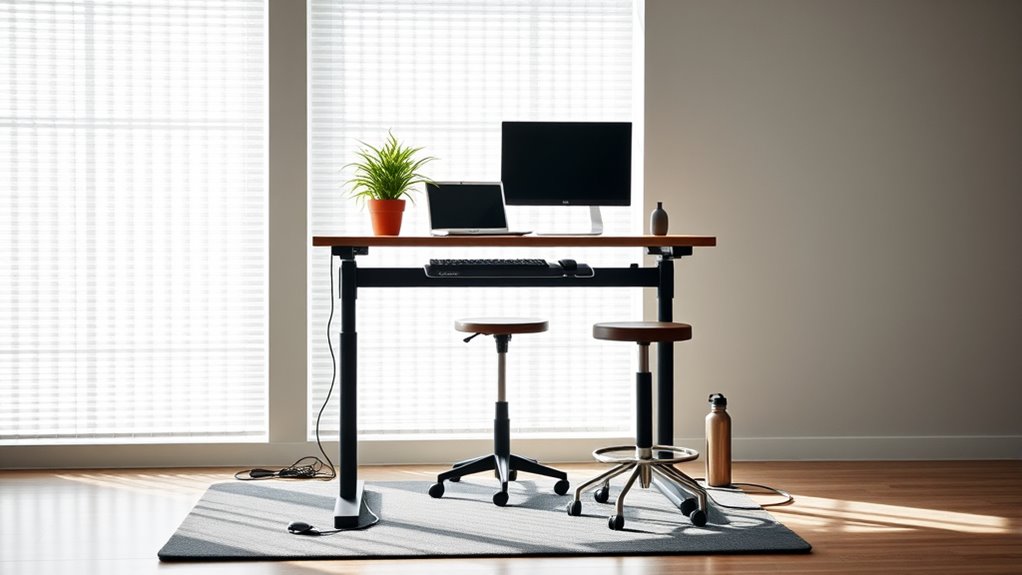
When you start using a standing desk, it’s best to make gradual adjustments so your body can adapt comfortably. Focus on setting up your workspace with proper ergonomics to prevent strain and discomfort. Taking small steps and ensuring your setup is correct will help you shift smoothly and sustainably. Additionally, being aware of cybersecurity threats, such as phishing or malware, can help you maintain a secure environment as you adapt to your new workspace security considerations. Incorporating ergonomic principles into your setup can further reduce the risk of repetitive strain injuries and promote long-term comfort. Understanding resources and tools available for ergonomic optimization can also enhance your overall workspace efficiency. Moreover, considering performance tuning techniques can help optimize your workspace environment for better productivity and comfort.
Gradual Adjustment Strategies
Switching to a standing desk gradually helps your body adapt comfortably and reduces discomfort. To make the transition smoother, consider these strategies:
- Start slow by standing for 15-30 minutes daily, then gradually increase your standing time.
- Optimize workspace organization by arranging your ergonomic accessories within easy reach, which encourages proper posture.
- Balance sitting and standing by alternating every hour, ensuring your body adjusts without strain.
- Be aware of market volatility when selecting gold products for your IRA, as fluctuations can impact your investment value.
This approach helps prevent fatigue and promotes comfort. Incorporate ergonomic accessories like anti-fatigue mats and monitor risers to support your new routine. Remember, patience is key—your body needs time to adapt to the change while maintaining an organized workspace.
Proper Ergonomics Setup
Achieving a proper ergonomic setup is essential for a comfortable and healthy shift to a standing desk. Start by adjusting your desk height so your elbows are at a 90-degree angle when typing, keeping your wrists straight. Use desk accessories like monitor risers to position your screen at eye level, reducing neck strain. Invest in a good standing desk mat to provide cushioning and support, minimizing fatigue during prolonged periods standing. Guarantee your monitor is directly in front of you to prevent twisting your neck. Keep your feet flat on the standing desk mat and shift your weight periodically to avoid discomfort. Proper ergonomics promotes better posture, reduces fatigue, and helps you maintain focus during your workday.
Maintenance and Adjustments for Longevity
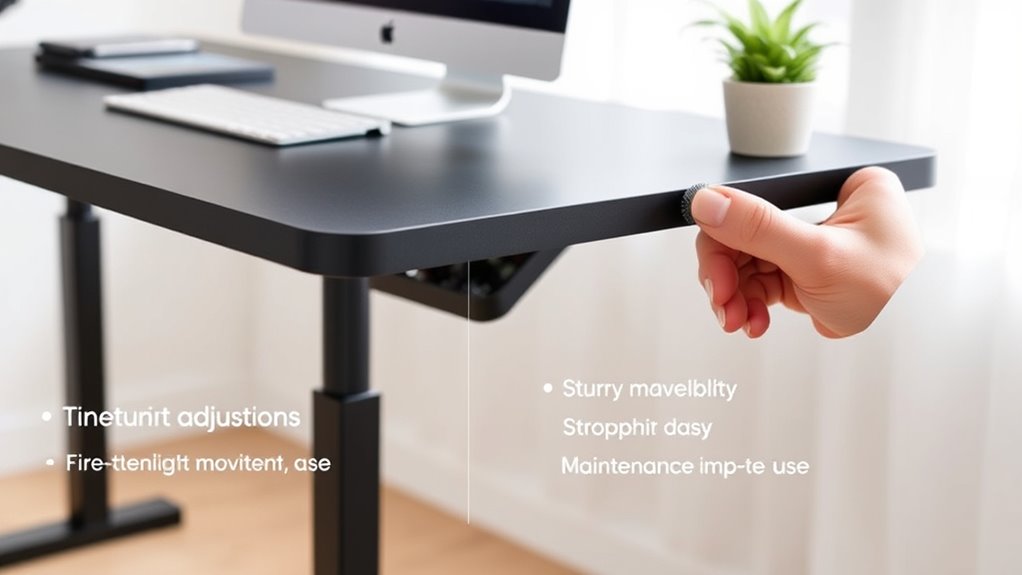
Regular maintenance and timely adjustments are essential to keep your standing desk functioning smoothly and to extend its lifespan. To do this effectively, focus on three key areas.
Regular upkeep ensures your standing desk stays smooth and lasts longer.
- Cable management: Regularly check and organize your cables to prevent tangles and wear, ensuring smooth movement and reducing hazards.
- Surface cleaning: Keep your desk surface clean and free of dust or spills that could damage the material or interfere with adjustments.
- Routine adjustments: Periodically tighten screws, check the stability of moving parts, and recalibrate height settings to maintain ideal performance.
Incorporating Movement and Breaks
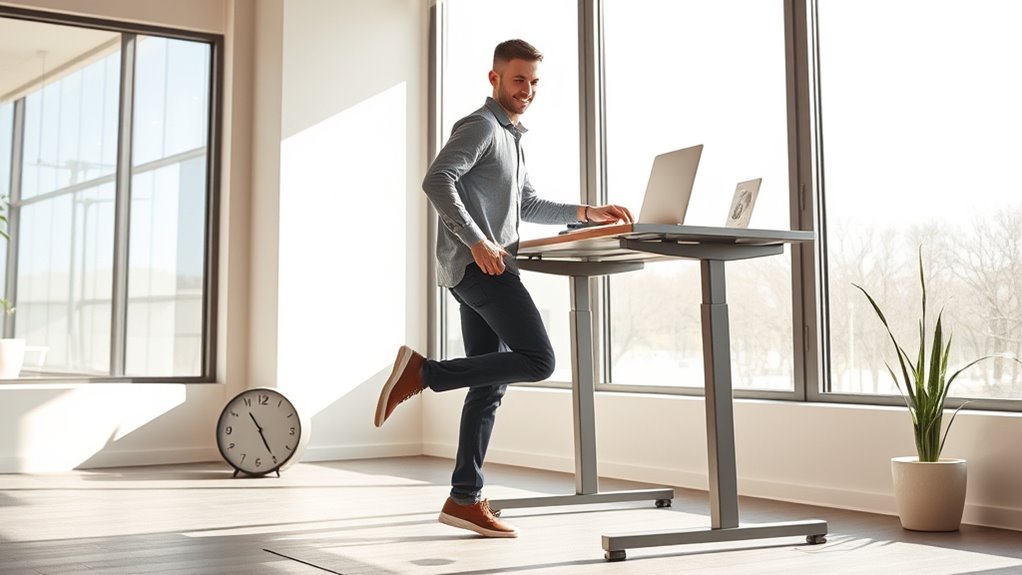
Incorporating movement and breaks into your routine is essential for maintaining your health and productivity while using a standing desk. Regularly shifting your posture helps prevent stiffness and encourages posture correction, reducing strain on your neck and back. Instead of remaining static, take short sitting alternatives like walking around or stretching every 30 minutes. These breaks boost circulation, increase energy, and help you stay focused. Use reminders or timers to prompt movement, ensuring you don’t forget to step away from your desk periodically. Incorporating simple activities like heel lifts, arm stretches, or brief walks can make a significant difference. By actively integrating movement, you support your overall well-being and maximize the benefits of your standing desk.
Frequently Asked Questions
How Much Does a Standing Desk Typically Cost?
When you’re wondering about how much a standing desk costs, it’s helpful to think about the price ranges and do a quick cost comparison. Generally, you can find basic models starting around $200, while more advanced or electric options might reach $1,000 or more. Your budget and features you need will influence your choice. Keep in mind that investing a bit more can offer better durability and comfort for long-term use.
Are Standing Desks Suitable for All Height Ranges?
Many believe standing desks suit everyone, but that’s not entirely true. You should investigate whether the desk offers ergonomic adjustments and height customization to fit your specific needs. If you’re tall or short, look for models that easily adapt. Proper height settings are essential for comfort and health, so make sure the desk can be customized to support your posture, making it suitable regardless of your height range.
Can Standing Desks Be Used for Seated Work?
Yes, you can use standing desks for seated work by adjusting them or using an ergonomic chair. Many desk converters let you switch between sitting and standing positions easily, providing flexibility. When seated, make sure your ergonomic chair supports proper posture. Adjust the height so your feet are flat on the floor and your hips are level. This way, you maintain comfort and reduce strain, whether you’re standing or seated.
What Are the Common Accessories for Standing Desks?
Imagine your workspace transformed with sleek monitor stands that lift your screens to eye level, reducing neck strain. You’ll also want cable management accessories that keep cords tidy, preventing tangles and clutter. These accessories make your standing desk more functional and organized, helping you focus on your work without distractions. With the right tools, your standing desk becomes a streamlined, comfortable space where productivity flows effortlessly.
How Do I Prevent Back Pain When Using a Standing Desk?
To prevent back pain when using a standing desk, focus on maintaining proper posture and frequently changing positions. Use an ergonomic mat to reduce foot and leg strain, which helps support your back. Make sure your desk has adjustable height so you can set it at a comfortable level, keeping your shoulders relaxed and your spine aligned. Taking regular breaks to stretch also helps prevent discomfort and promotes better back health.
Conclusion
Embracing a standing desk is like planting a seed for better health—you’ll watch your energy grow and your posture flourish. With the right setup, regular movement, and a little patience, you’ll turn your workspace into a haven of productivity and wellness. Remember, change is a journey, not a sprint. So stand tall, stay committed, and let your new desk be the foundation for a healthier, more energized you.









